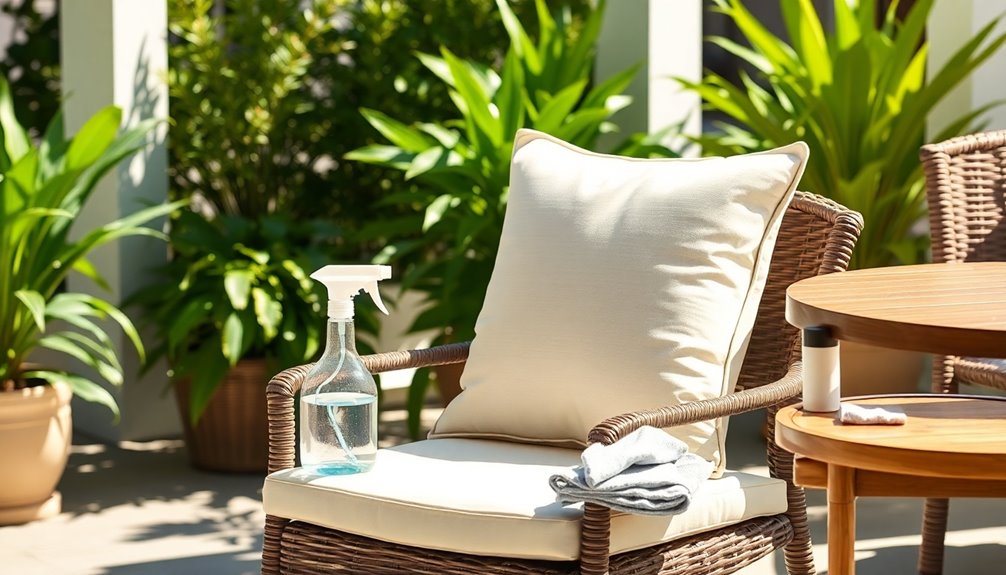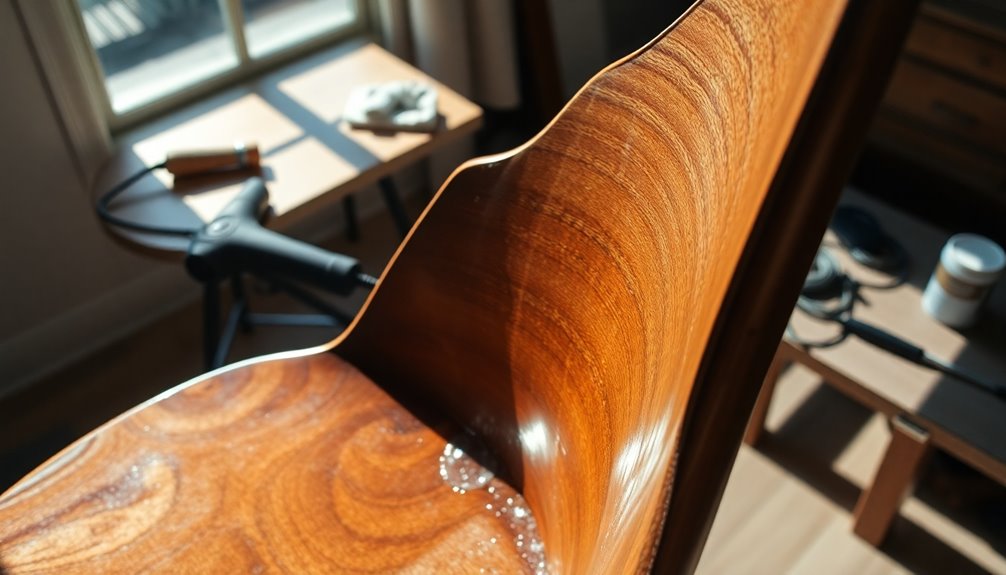To keep your outdoor furniture clean, start by removing loose debris with a soft brush. Use mild soap and water to scrub surfaces, adjusting techniques based on material—wood and metal need special care. Rinse thoroughly with a garden hose and allow furniture to dry naturally in a shaded area. Conduct regular checks for rust or loose screws and consider applying protective coatings to extend its life. Storing furniture during harsh weather also helps. For the best results, you might want to explore additional tips and tricks to maintain that fresh look year-round.
Key Takeaways
- Regularly remove debris and dust from surfaces to prevent buildup and staining on outdoor furniture.
- Use mild soap and water to clean different materials, avoiding harsh chemicals that can cause damage.
- Inspect furniture regularly for rust or loose screws and address any issues promptly to maintain integrity.
- Apply protective coatings like rust-resistant finishes for metal and sealants for wood to enhance durability.
- Store furniture in dry areas during off-seasons and use covers to protect against harsh weather conditions.
Preparation and Initial Cleaning
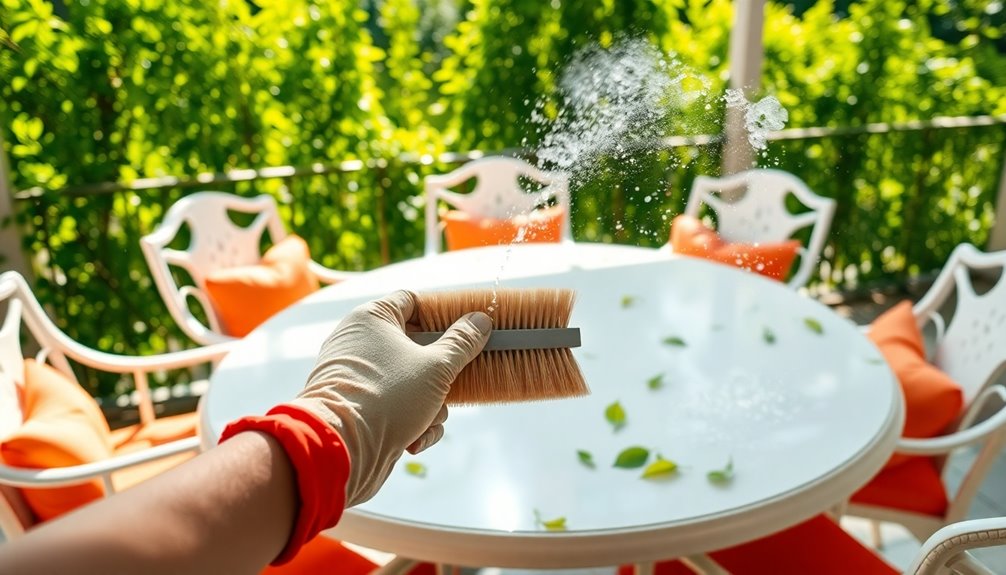
Keeping your outdoor furniture clean starts with proper preparation and initial cleaning. First, gather your supplies: a soft-bristled brush, mild soap or wood-specific cleaner, water, a microfiber cloth, and sandpaper if necessary. Next, remove any loose debris—brush off dirt, leaves, or dust from the surface. Before diving into cleaning, inspect your furniture for stains or areas needing special attention. Make sure your cleaning area is well-ventilated and free of obstacles. Once you’ve completed the initial preparation, you can move on to treating any specific stains with appropriate solutions or natural cleaning methods for wood. For stubborn marks, consider using a mixture of equal parts vinegar and water to gently scrub the area with your soft-bristled brush. After cleaning, give your furniture a thorough rinse with water and dry it with a microfiber cloth to prevent moisture damage.
Now, it's time for initial cleaning. Use your soft-bristled brush or a vacuum cleaner with a brush attachment to remove dirt and dust. Mix your cleaning solution according to product instructions and apply it gently with a soft cloth or brush. Be cautious—avoid harsh chemicals that can damage the finish. If you're trying a new cleaner, always test it on a small, inconspicuous area first. Regular cleaning prevents rust formation on metal furniture, which helps maintain its appearance and durability.
For intricate pieces, consider using a toothbrush for tight spaces. In summary, thorough preparation and careful initial cleaning lay the foundation for maintaining your outdoor furniture's beauty and longevity. Regular upkeep will make your cleaning efforts even easier down the line!
Cleaning Specific Materials
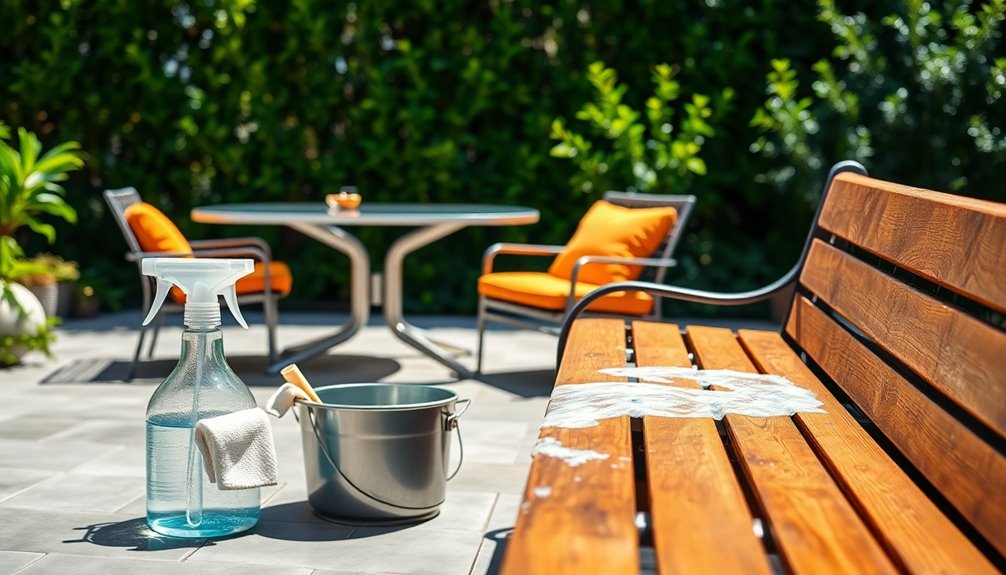
When it comes to cleaning outdoor furniture, understanding the material is key to maintaining its appearance and longevity. For wood furniture, start by using a broom or brush to sweep away dirt and debris. Then, mix mild dish soap with water and use a rag to wipe down the surfaces, avoiding harsh chemicals that can harm the wood. Consider applying a waterproofing wood sealant annually and using wood conditioner to prevent drying and cracking. Regular cleaning enhances furniture lifespan, maximizing your investment in outdoor seating.
For metal furniture, a solution of 1 part detergent to 3 parts water works wonders. Use a soft rag to spot-clean scuff marks, and rinse off any excess detergent with a garden hose. After cleaning, dry the surfaces with a cloth to avoid water spots. Regularly apply a rust-preventative coating, especially in humid conditions.
If your furniture is made from plastic or resin, stick with mild dish soap and water. You can sprinkle baking soda on a sponge for tougher stains. No matter the material, always store your furniture in a cool, dry place, and cover it to protect against dust and debris. Regular maintenance will keep your outdoor furniture looking great for years to come.
Scrubbing and Rinsing
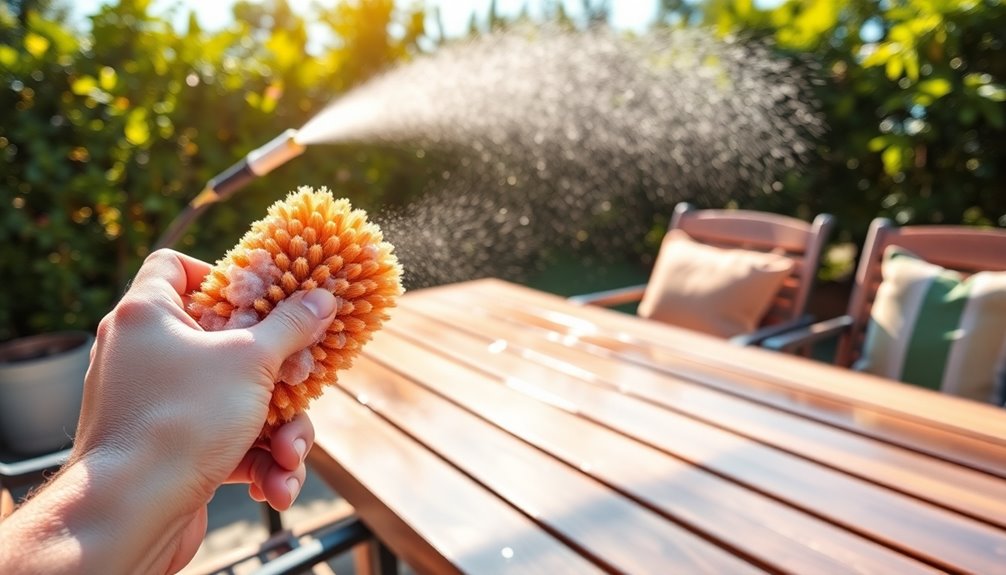
To effectively clean your outdoor furniture, start by preparing the area and your cleaning supplies. Remove any cushions and fabric, along with visible debris. Use a vacuum with a dust-brush attachment or a dry paintbrush to get rid of dirt and dust. Fill a bucket with warm water and add a gentle soap or detergent, mixing according to the recommended ratio.
When scrubbing, begin at the top of the furniture and work your way down to avoid spreading dirt. Use a soft-bristled brush for gentle scrubbing, alternating strokes for wicker furniture. For metal surfaces, stick to mild detergents and avoid abrasive materials that could scratch. Make sure to scrub all surfaces thoroughly, changing the bucket water as needed. It's advisable to gather cleaning supplies such as dishwashing liquid, microfiber cloths, and a commercial cleaner before starting the process.
Once you've scrubbed everything, it's time to rinse. Use a garden hose with a high-pressure setting to wash away dirt and soapy water. For delicate surfaces, opt for a softer setting to prevent damage. Rinse thoroughly to remove any soap residue and ensure all areas are clean. This step will help maintain your outdoor furniture's appearance and longevity.
Drying and Maintenance
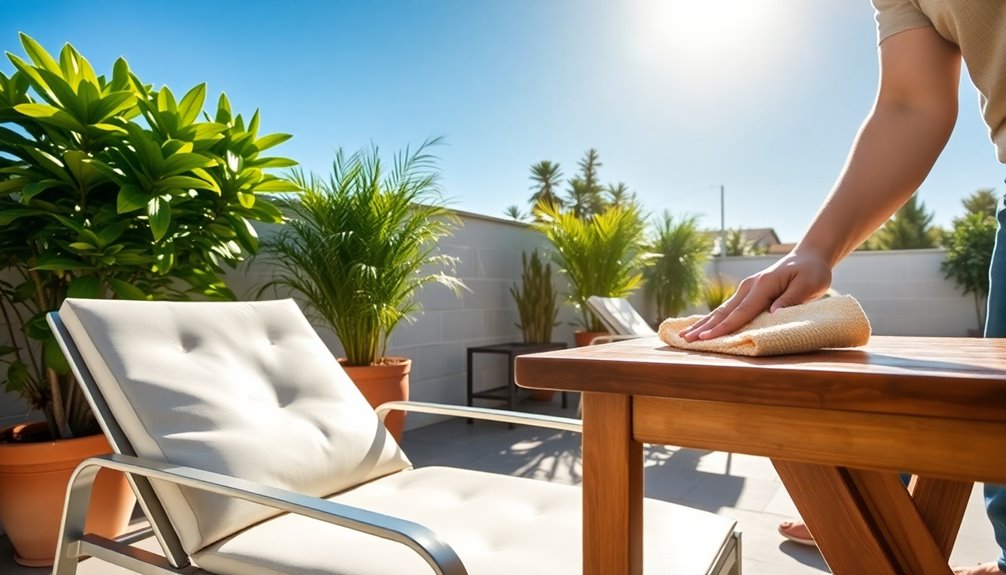
After rinsing your outdoor furniture, drying it properly is vital for maintaining its condition. For wood furniture, natural drying is your best bet. Place it in a clean, cool, dry, and shady area, stacking the wood on raised foundations to enhance air circulation. Keep in mind that this process may take time, depending on the weather. If you need quicker results, consider artificial drying using controlled kilns, which allows for better temperature and humidity management. Proper drying is essential for the durability and longevity of teak wood furniture.
When drying outdoor cushions, start by squeezing out as much water as possible. You can stand on them to press out water and then blot the remaining moisture with a towel. Hang them on a clothesline or over a railing to let them drain. Position cushions in sunny, yet not overly direct, sunlight to speed up drying while preventing fabric fading. Rotate and flip them periodically to ensure even drying on all sides.
For wood furniture maintenance, apply a sealant or stain annually and store it in a dry place during off-seasons. Regularly inspect for wear, and use covers when not in use to protect against the elements.
Using Commercial Cleaners
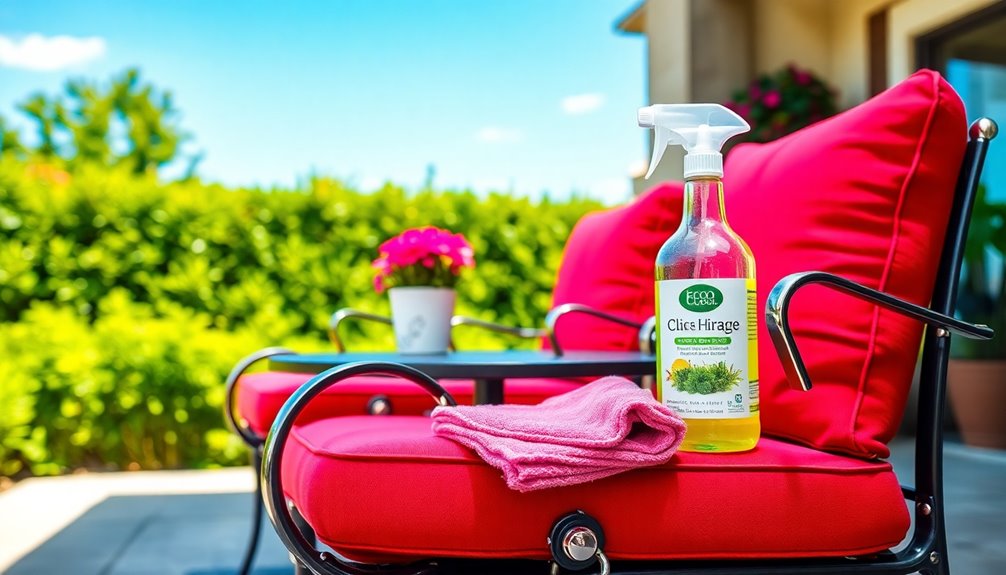
For a quick and efficient way to keep your outdoor furniture clean, using commercial cleaners can be a game-changer. Products like Hauser's Patio Furniture and Fabric Cleaner are safe for various materials, making them ideal for your furniture. CLR Outdoor Furniture Cleaner is specially formulated to tackle dirt and grime on surfaces like resin, wood, and vinyl, ensuring a thorough clean.
When you use these cleaners, the spray-and-wipe method is straightforward. Just spray the cleaner on the affected area, let it sit for a few minutes, and wipe it away with a clean cloth or sponge. If you want a deeper clean, some options are compatible with pressure washers. Plus, their non-abrasive formulas mean you won't damage your furniture while cleaning. Additionally, it's important to consider that seasonal cleaning is recommended to address the accumulation of dust, dirt, and grime after winter exposure.
Eco-friendliness is also a key feature; for example, Hauser's cleaner uses all-natural ingredients, while CLR won't harm your grass. Many of these cleaners effectively remove tough stains and leave no oily residue behind. With options like Nuvera® Patio Furniture Cleaner, you even get UV protection to help maintain your furniture's appearance. Using commercial cleaners makes caring for your outdoor furniture easy and effective.
Preventative Measures

Maintaining your outdoor furniture can save you time and effort in the long run, and implementing preventative measures is key. For wooden furniture, apply a coat of UV-blocker polyurethane, like Varathane Ultimate Spar Urethane, to shield it from sun and moisture. After cleaning and drying, use teak oil or wood polish to keep it looking fresh. Avoid abrasive cleaners or pressure washing, and regularly inspect your pieces to catch any damage early. Regular inspections are essential to ensure you address any issues before they worsen.
With metal and aluminum furniture, apply a coating of paste wax to combat corrosion and rust. If rust does appear, remove it, then use primer and paint before adding wax. Positioning metal items in shaded areas helps minimize sun exposure and prevents movement during high winds.
For plastic furniture, use an outdoor protector to prevent fading and cracking. Clean with a baking soda and water mixture, ensuring you rinse thoroughly. Lastly, for fabric and wicker furniture, spray on a sun and water shield, and store cushions indoors during the off-season. Use a vacuum with a soft-bristled attachment for wicker, and keep it out of direct sunlight to avoid damage.
Tips for Long-Term Care
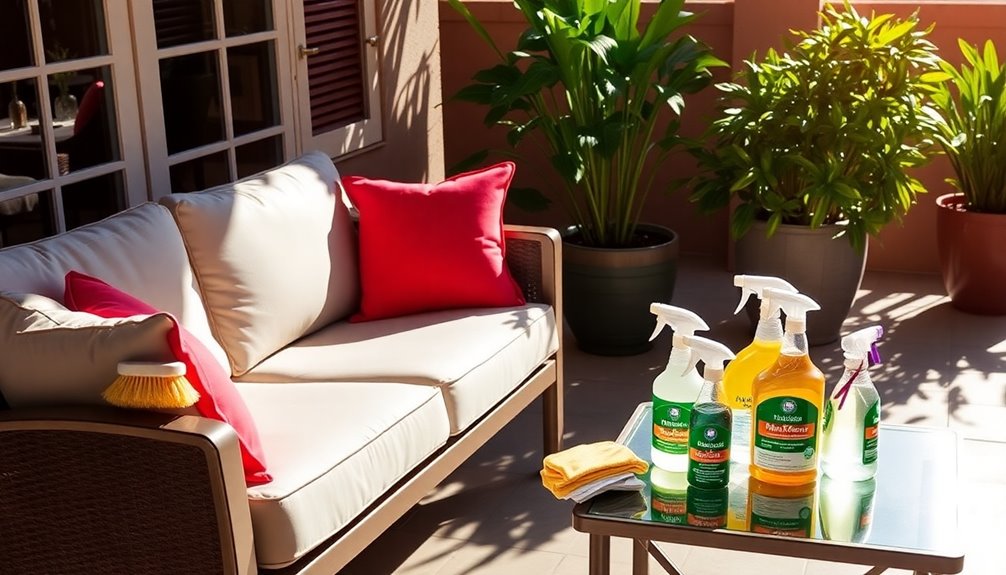
Keeping your outdoor furniture in top shape requires consistent care and attention. Start by cleaning your furniture regularly based on its material. For aluminum, use a damp cloth with mild soap, and polish painted surfaces to maintain their appearance. Woven or resin furniture benefits from a mild detergent wash and UV light stabilizers to resist fading. If you have composite furniture, hose it down and scrub with non-abrasive cleaners to prevent mold growth. Wood furniture needs dusting and an annual application of sealant to guard against weather damage. Additionally, aluminum furniture is particularly ideal for creating low-maintenance outdoor spaces.
Regular inspections are crucial. Check for loose screws or signs of rust, and address these issues promptly. Applying protective coatings, like rust-resistant finishes for metal and sealants for wood, enhances durability. During the off-season, store your furniture in a dry place, and use covers during harsh weather to protect against moisture.
Finally, clean spills immediately to prevent lasting damage. By following these tips, you'll not only preserve the look of your outdoor furniture but also extend its lifespan, ensuring you enjoy it for years to come.
Seasonal Cleaning Checklist
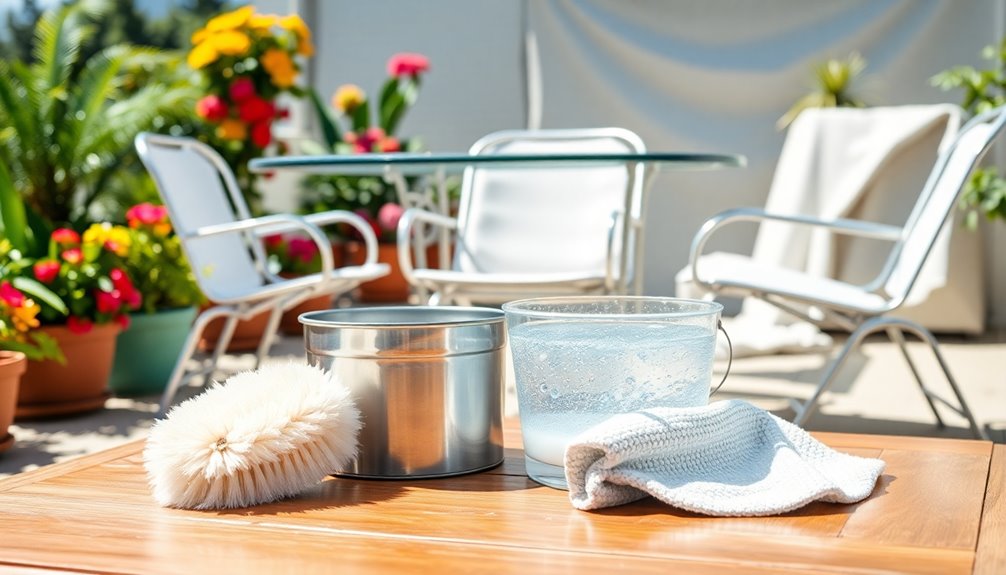
As the seasons change, it's essential to give your outdoor furniture a thorough cleaning to prepare it for use. Start by inspecting each piece for damage or wear from winter storage. Tighten any loose screws or bolts, and clear away debris or dirt that might have accumulated. Use a leaf blower to remove cobwebs, insects, and leaves from your outdoor area.
Next, deep clean your furniture. For metal pieces, wash them with soapy water and a soft brush, then rinse and dry to prevent rust. Clean wooden surfaces with a wood cleaner, and oil them to restore their sheen. If your cushions have removable covers, launder them; otherwise, use fabric cleaner for non-removable ones. Additionally, remember to sweep away debris from your patio area to create an inviting space for relaxation.
You'll want to spot clean wicker furniture and scrub off any light rust from wrought iron. For plastic, a dish soap solution works well, while tougher stains may need bleach. After cleaning, apply a UV protectant to synthetic materials and a water-repellent finish to wood. Finally, cover or store furniture in a dry, shaded place when not in use, and regularly wipe down surfaces to maintain cleanliness.
Frequently Asked Questions
How Often Should I Clean My Outdoor Furniture?
You should clean your outdoor furniture based on its usage and the climate. If you use it frequently or live in a coastal area, aim for every 1-2 weeks. For less frequent use, a quick wipe-down before guests arrive works well. Increase your cleaning during peak seasons like summer, but if you're in a mild climate, you can reduce the frequency. Always deep clean at least once a season to prevent buildup.
Can I Use Bleach to Clean Outdoor Furniture?
Yes, you can use bleach to clean certain outdoor furniture materials, but be cautious. For plastic and resin, mix 1/3 cup of bleach with a gallon of water and apply it. Wood needs to be sealed beforehand. Avoid bleach on metal, especially non-stainless options, and be careful with glass. Always wear protective gear and rinse thoroughly to avoid damage. Test on fabrics first to ensure color safety. Regular cleaning helps maintain your furniture.
What Should I Do for Rust on Metal Furniture?
If you notice rust on your metal furniture, start by scrubbing the affected area with aluminum foil dipped in saltwater to remove the rust. If it's more severe, sand the rusty spots lightly and apply rust-proof touch-up paint. You can also use a solution of equal parts white vinegar and water for aluminum surfaces. After cleaning, make sure to dry everything thoroughly to prevent further rust from forming. Regular maintenance is key!
Is It Safe to Use a Pressure Washer on Outdoor Furniture?
It's generally safe to use a pressure washer on outdoor furniture, but you need to be cautious. For hard-wearing plastic and metal furniture, a lower pressure setting works best. Start from a distance and test a small area first to ensure it's safe. Avoid using a pressure washer on rattan or wooden pieces, as it can cause damage. Always adjust your technique based on the material to prevent any harm.
How Can I Remove Stubborn Stains From Fabric Furniture?
To remove stubborn stains from fabric furniture, start by checking the care label for guidance. Act quickly on stains, gently scraping off dried residues first. For tough spots, dab with rubbing alcohol or use a mixture of water and vinegar. Blot food spills with a clean cloth and apply a mild detergent solution. Rinse thoroughly after cleaning, and let the fabric air dry to maintain its quality and appearance.
Conclusion
Keeping your outdoor furniture clean is essential for its longevity and appearance. By following the steps outlined, like regular cleaning, proper drying, and using the right materials, you can keep your furniture looking great season after season. Don't forget to implement preventative measures to minimize dirt buildup and protect your pieces from the elements. With a little effort, you'll enjoy a beautiful outdoor space that's ready for relaxation and entertaining. Happy cleaning!
